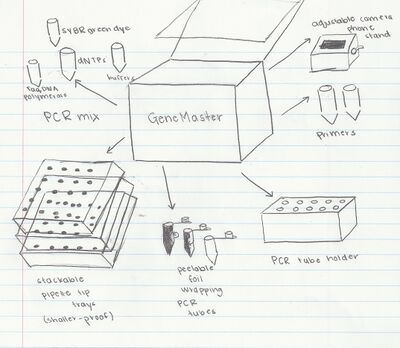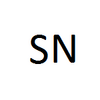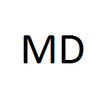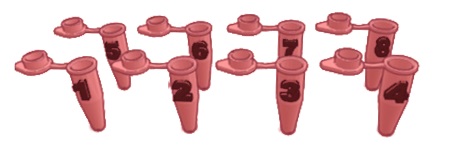BME100 f2013:W1200 Group11 L6
| Home People Lab Write-Up 1 | Lab Write-Up 2 | Lab Write-Up 3 Lab Write-Up 4 | Lab Write-Up 5 | Lab Write-Up 6 Course Logistics For Instructors Photos Wiki Editing Help | ||||||
OUR TEAM
LAB 6 WRITE-UPComputer-Aided DesignTinkerCAD
Feature 1: Cancer SNP-Specific PrimersBackground on the cancer-associated mutation Primer design
Primers start by recognizing the "target sequence", which is the cancer oriented SNP known as rs17879961. This specific cancer reverse primer will locate the complementary target sequence in the cancer SNP template to bind together. The primer needs to find a matching target sequence to properly bind together. The non-cancer allele includes the sequence ATT, but the cancer allele includes the sequence ACT. The forward primer like reverse primer must find a complementary sequences to be able to bind together. However, the primer will not bind to the patient's sample unless it can bind to every single part of the template strand. Therefore, even if it is off a little bit the PCR reaction will not happen and the strand will not amplify. The result for cancer will be negative. If the template strand is cancer positive, however, then then they will match and the strand will amplify. The result for cancer will be positive in this case. Feature 2: Consumables Kit The GeneMaster PCR kit contains a collection of materials and consumables necessary to conduct PCR. Our kit contains PCR mix, which includes tubes of Taq DNA polymerase, dNTPs, SYBR green dye, and polymerase buffers. It also contains primers and pipettors. Additionally, the kit contains an adjustable camera phone stand which will be used for the fluorimeter. One problem encountered with the current camera phone stand was that it was very unstable and difficult to position. In fact, some student groups had to find extra materials to place under the stand to ensure that the phone was at an adequate height for picture-taking. In order to solve this problem, the GeneMaster PCR kit contains an adjustable camera phone stand, which is more sturdy due to a wider rectangular base, and easier to customize with a handle which elevates or depresses the platform. The camera phone stand also has a component that allows it to be attached to the base of the fluorimeter. This allows the camera phone stand to be used with phones of a variety of shapes and sizes without shaking or movement of the camera phone stand. Therefore, the process of picture-taking will be far more efficient and convenient and the device is able to be used by a variety of students and researchers. The kit will also contain plastics which are used to store consumables. There will be a collection of PCR tubes, a PCR tube holder which can be used to organize tubes during a reaction, and stackable pipette tip trays. The PCR tubes will be arranged in strings of plastic connected to one another. Packaging of the PCR tubes can be carried out in a way that effectively prevents a major problem encountered throughout the process: bleaching of the SYBR green dye. The PCR tubes as well as tubes used to contain this dye should be covered with a light-blocking foil that can be removed manually when necessary. This will minimize contact between the dye and light, ensuring that the SYBR green dye remains potent. However, if the SYBR dye has to be observed for whatever reason or if the content of the tube has to be viewed, the foil can be peeled off. Additionally, packaging can be made more compact by stacking pipette tip trays atop one another, rather than having a collection of many trays that take up unnecessary space. These pipette tip trays should be placed in a shatter-resistant, cohesive container that will keep the trays intact even when dropped.
Feature 3: PCR Machine HardwareThe PCR machine will be assembled in a similar way that was followed in lab. The PCR machine will be made of wood and will contain all of the same features and components of the machine used currently. However, a few changes will be made in order to resolve some inconveniences which were encountered. An inconvenience encountered during the use of the given PCR machine hardware was having to hook up the PCR machine to the computer in order to display results. This frequently caused problems due to additional materials being needed and a lack of quality in the cable connecting the PCR machine and the computer. Instead, it would be much more convenient to simply be able to view the results on the PCR machine itself. In order to accomplish this, the PCR machine hardware would have to be redesigned in order to include a large screen and display system programmed to take in instructions and show completion of the cycles. Also, the LED display could be improved. Overheating in the PCR machine system caused the LED display to burn out and stop working. Designing and implementing a better cooling system with fans within the machine could help users avoid this problem. Feature 4: Fluorimeter HardwareThe fluorimeter is still necessary in order to analyze the fluorescence of the drop of the SYBR/PCR sample and find out if it is similar to a cancer sequence. A cell phone camera with a timer is used to get the initial picture and in order for it to align with the drop of SYBR/PCR, it is placed on a stand that keeps the phone perpendicular to the table. The bottom of the stand is permanently attached to the block ensuring that the phone camera is always exactly 10 centimeters away from the drop of SYBR/PCR. Finally, a big black box is used to block out any external light and ensure that the picture is clear/accurate. One of the main problems with the original design is that the stand was always moving around and a ruler had to continually be used to measure the distance between the stand and the box. In order to remedy this, the stand was attached to the box at a set distance away from it so the phone wouldn't move over the course of the experiment and the results would be accurate. Another problem was that the phone was never perfectly perpendicular and always fell over. The phone never stood properly and caused a lot of problems because it kept falling over. Whenever a button was pressed on the phone, the picture got out of focus because it kept moving around. In order to remedy this, a clamp will be introduced on the new version so the phone will be held in place and will always be centered with respect to the drop. Whenever a button is pressed on the phone, the phone will not move and will never go out of focus. With the box and the stand being a permanent 10 centimeters away, and the phone being secured on the stand, the process will be substantially smoother and easier as the phone will not tip over, the light conditions will be consistent, the distance will always be constant, and the phone will never go out of focus because it will be held in place and it will not move around. Thus, a reliable and accurate measurement of fluorescence in the drop of PCR/SYBR will be taken with every trial. Bonus Opportunity: What Bayesian Stats Imply About The BME100 Diagnostic ApproachBayesian statistics help test the reliability of the machine in terms of sensitivity and specificity. Calculation 3 is the sensitivity of the PCR machine to predict cancer. The value is the probability that a cancer patient will test positive when using the PCR machine. The percentage was extremely small which means that the machine was not sensitive. Therefore the machine is not reliable at all in terms of sensitivity. Calculation 4 is the specificity of the PCR machine to predict cancer. The value is he probability that a non-cancerous patient will test negative when using the PCR machine. The percentage was larger than the one in calculation 3 but was still far from 1. This means that a non-cancerous patient was often given a cancer diagnosis. Using Bayesian Statistics, the CHEK2 PCR proved to be not reliable in terms of both sensitivity and specificity. Therefore, it is not a good standard for predicting cancer. |
||||||





